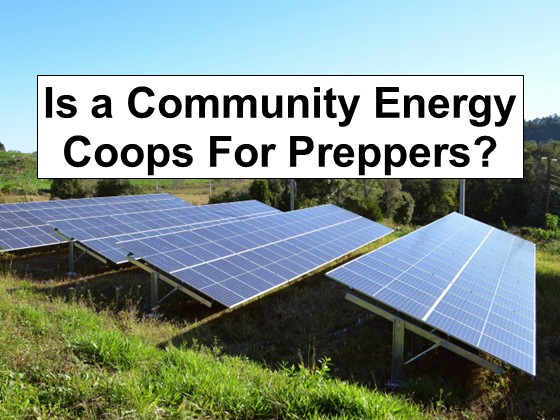The most skilled preppers know they won’t be able to trust the national grid to deliver electricity when catastrophe strikes. You can establish a backup plan with energy cooperatives. These resources are critical for connecting communities and building resilience against disasters of all types, whether environmental or socioeconomic.
Understanding Community Energy Cooperatives
Energy cooperatives provide you with a not-for-profit solution to energy access in an emergency. When establishing your preparedness strategies, know these foundational insights about how they work.
The Structure of Energy Cooperatives
Your role in an energy cooperative would be more involved than the passive participation in federal assets. Members are often part-owners instead of answering to a board of corporate shareholders within the bureaucratic structures of utility companies. The customers are the leaders, allowing democratic decision-making for the good of the many.
These can tie neighborhoods together, which is crucial when maintaining productive, optimistic mindsets in doomsday scenarios.
Types of Energy Sources
Most energy cooperatives thrive on renewable energy generators like solar, wind and water. These facilitate microgrids and energy-independent operations at a more local level instead of putting full dependence on central grids.
Currently, these organizations make up 33% of the electricity industry, playing an essential role in clean power adoption — especially when 95% of cooperatives use renewables.
Benefits of Community Energy Cooperatives
This structure gives you access to local power resources regardless of what’s happening in your state or country. The decentralized setup provides every member with peace of mind, knowing they can remain safe when it hits the fan.
Cooperatives also educate people about the inadequacies of government-run critical infrastructure because they aren’t foolproof from a security or financial standpoint, and could also still be relying on fossil fuels. Independent entities are more sustainable from every point of view, protecting themselves from:
- Emitting excessive greenhouse gases.
- Nationally targeted cybersecurity threats.
- Financial volatility from a failing market.
Maintaining consistent power transmission during a crisis also makes communities healthier. Your system and co-op will recover faster because you’re disconnected from traditional services. It does not have as many connections as national setups to distribute resources. This connectivity keeps families out of the elements that could lead to hospitalizations, as they will have reliable access to temperature control and refrigeration.
Steps to Establish a Community Energy Cooperative
These are the actions you need to take today to get engaged with your nearby co-op. This plan will also ensure the community stays organized and communicative before, during and after disasters.
Assess Community Needs
You and other caring citizens need to find out everyone’s energy requirements. Start this process as soon as possible, as it will take time. It often requires manual surveying and interviews to discover how households use their power and how those behaviors would change during an emergency.
Members are also responsible for creating a diverse energy portfolio with the most sensible renewable energy options. Community solar may be nearby, but the closest geothermal heat pump provider could be a state away. Considering backup solutions, like battery energy storage, is also vital for establishing resilience.
Build a Cooperative Structure
While energy cooperatives are member-ran, some structure is essential for delegating responsibilities. Everyone can choose together who assumes what roles. If you have access to legal experts, then you have an advantage. They could advise on how to get permits and licenses for operating off-grid. Be sure to play into everyone’s strengths, empowering them by giving them reasonable yet impactful responsibilities.
Secure Funding
Installing tons of residential wind turbines, electric vehicle chargers or rooftop panels is expensive, which is why initiatives need to start now to be established before catastrophe. You can look into grants and loans in addition to more experimental options like crowdfunding. Use the data you gathered at the survey stage to determine cost-per-watt.
Connect With the Community
Not everyone in your community might share your level of preparedness commitment. However, you should challenge yourself to have conversations at local events or workplaces about why considering energy cooperatives could be beneficial for them in the short- and long-term. Once you establish a solid group of like-minded individuals, it will be easy to build momentum.
Prepare for Challenges and Regulatory Hurdles
While energy cooperatives seem like a wonderful solution to fight dominant utility structures, the members will need to overcome some obstacles first. Establishing the group and installing technology could require adherence to local, state and federal laws. These include grid interconnection policies actively discouraging community-based developments and efforts.
Let this motivate you and your members instead. Here are a few other considerations to plan for so you get started on the right foot:
- High upfront costs for technologies and infrastructure
- Time investments in financial planning
- Social upkeep in maintaining community engagement outside of crises
- Access to continuing education about how to manage the co-op and decentralized assets
With aspirational attitudes, groups worldwide can reach the engagement levels of nations like Denmark, where around 20% of energy comes from wind.
Finding Power When the Lights Go Out
If every government structure falls, you will come out on top because you thought ahead by joining an energy cooperative. By doing this, you’re engaging with neighbors to establish utility independence and combat the monopolization of essential resources people need during emergencies. Take a stand today by contacting an organization and making your prepping plans even more robust.
[Note: This was a guest post.]

Leave a Reply